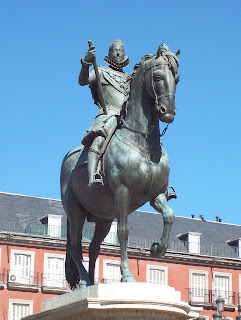Statue of Felipe III

The statue of Felipe III stands in the centre of Plaza Mayor. It shows King Felipe (Philip) III of Spain sat atop his horse in bronze; he has been remembered as "Philip the Pious" as a result of his strong religious beliefs. It was designed and sculpted by Jean Boulogne, an Italian artist, but completed by Pietro Tacca following Boulogne´s death. The statue originally stood in the Casa de Campo until 1848 when it was moved by Queen Isabella II to Plaza Mayor during her redesign of many of the city´s royal parks. During the Franco dictatorship, many statues and monuments to the Spanish royal family were destroyed, and it is an interesting story as to why this statue survived. The mouth of the horse was an open hole for a number of years prior to Franco, allowing a huge number of sparrow to fly into the horse and get trapped. Unable to get out, the birds starved to death inside the statue. This was unknown for years until an attempt, as decreed by Franco, to topple and demolish...












